It was about 1 a.m. on the island of Great Tobago, and Susan Zaluski was trying to capture a magnificent frigate bird.
She stepped gingerly across guano-spattered stones, shining her headlamp into the twiggy nests atop shoulder-high sea grape trees. At her approach, some of the large seabirds snapped their long, sharp beaks in rapid bursts of staccato clicks. Others trilled spooky shrieks in the dark.
Ms. Zaluski, the director of the Jost Van Dykes Preservation Society, was followed closely by Israel Bahadoor of the National Parks Trust and Atoya George of the Conservation and Fisheries Department. They had already tagged three frigate birds that night, and they hoped to tag a fourth before hiking back to their camp on the other side of the island.
It hadn’t been easy going. Many birds were absent from their nests, probably on foraging trips; others were sitting on eggs, and the team didn’t want to disturb them.
After skirting the edge of the colony for several minutes, Ms. Zaluski found what she was looking for: an adult with a chick, which she believed would be unlikely to abandon its nest due to the stress of the tagging process.
Without a word, she used a fishing net to scoop up the bird, exposing a fuzzy white chick which Mr. Bahadoor promptly covered with his cap.
After slipping a pillowcase over the adult’s head to calm it, Ms. Zaluski passed the wriggling bundle to Mr. Bahadoor.
“He is a strong one,” she said before comforting the bird in a motherly singsong: “It’s all right, buddy.”
As Mr. Bahadoor held the bird firmly in his lap, Ms. Zaluski spread its tail and affixed a plastic-covered transmitter to its feathers with black marine tape. Then Ms. George handed her a notebook, which she used to record the tag number and other information.
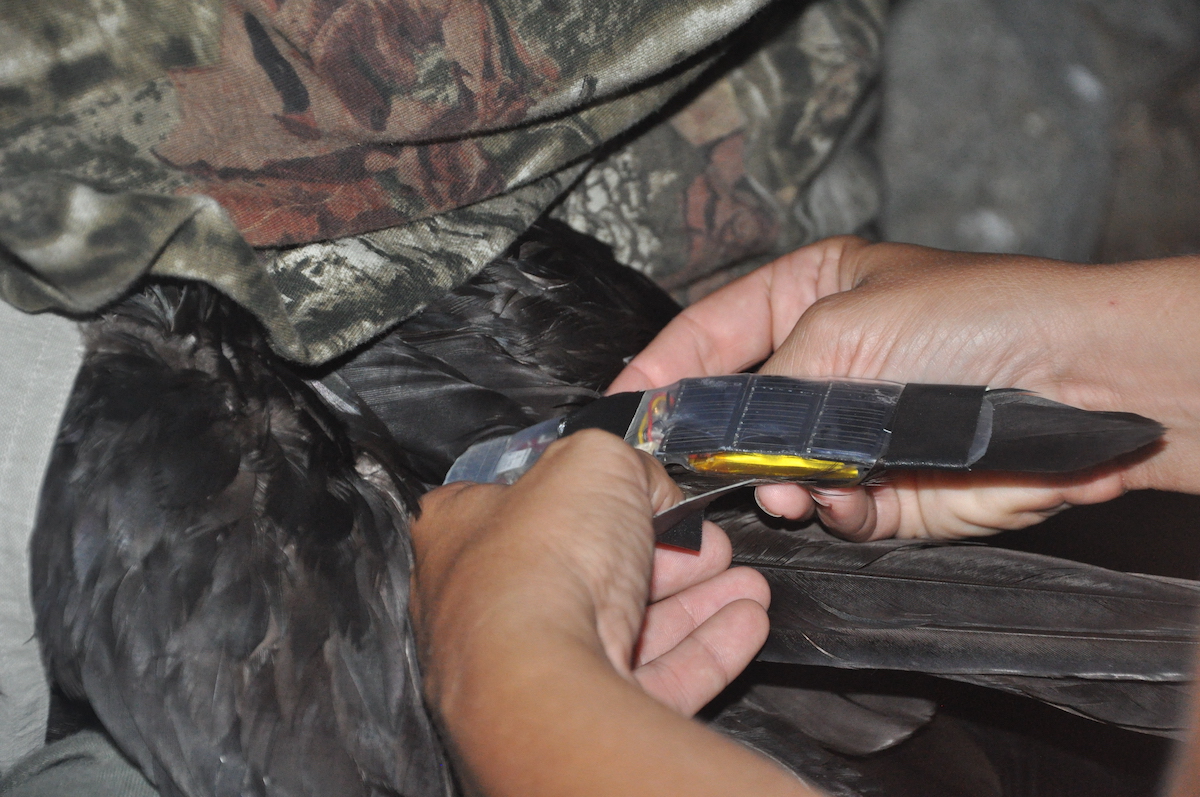
Less than five minutes after she’d captured the bird, Ms. Zaluski carefully returned it to its nest. It spread its five-foot-plus wingspan as though preparing to take flight. But after flapping a few times in jerky slow motion, it settled down on top of its chick. Ms. Zaluski chuckled.
“As graceful as they are in the sky,” she said, “they’re extremely awkward on land.”
The February visit was the latest in a series of collaborative efforts: Since 2013, researchers from here and abroad have worked together to tag nearly 30 seabirds on Great Tobago. By tracking the birds’ movements, the partners hope to better understand how to protect them and the ecosystems where they live and forage.
The colony
Magnificent frigate birds, known locally as “men o’ war,” are a common sight in the Virgin Islands. They often follow ferries and other boats, or soar in circles high above the territory. With a wingspan that can exceed seven feet — which gives them the largest wingspan-to-bodyweight ratio of any bird — they can stay aloft for several days during foraging trips hundreds of miles from land. To eat, they swoop low over the ocean without ever touching the water with their feathers.
“Everything they get they skim off the surface,” Ms. Zaluski said. “They don’t have waterproofing on their wings.”
However far they fly, they return home to breed.
“Sometime August to October, they form a pair and then they lay one egg,” she said. “And it takes them a year to maybe 18 months to raise that chick. The parents will work in shifts, so there’s always one bird on the nest while the other parent is out.”
Frigate birds prefer to nest on secluded islands in the ocean. Great Tobago, whose uninhabited 210 acres have been a protected national park since 1995, is ideal: About 900 pairs nest on the island’s northeastern shore, which hosts one of the three largest frigate bird colonies in the Caribbean.
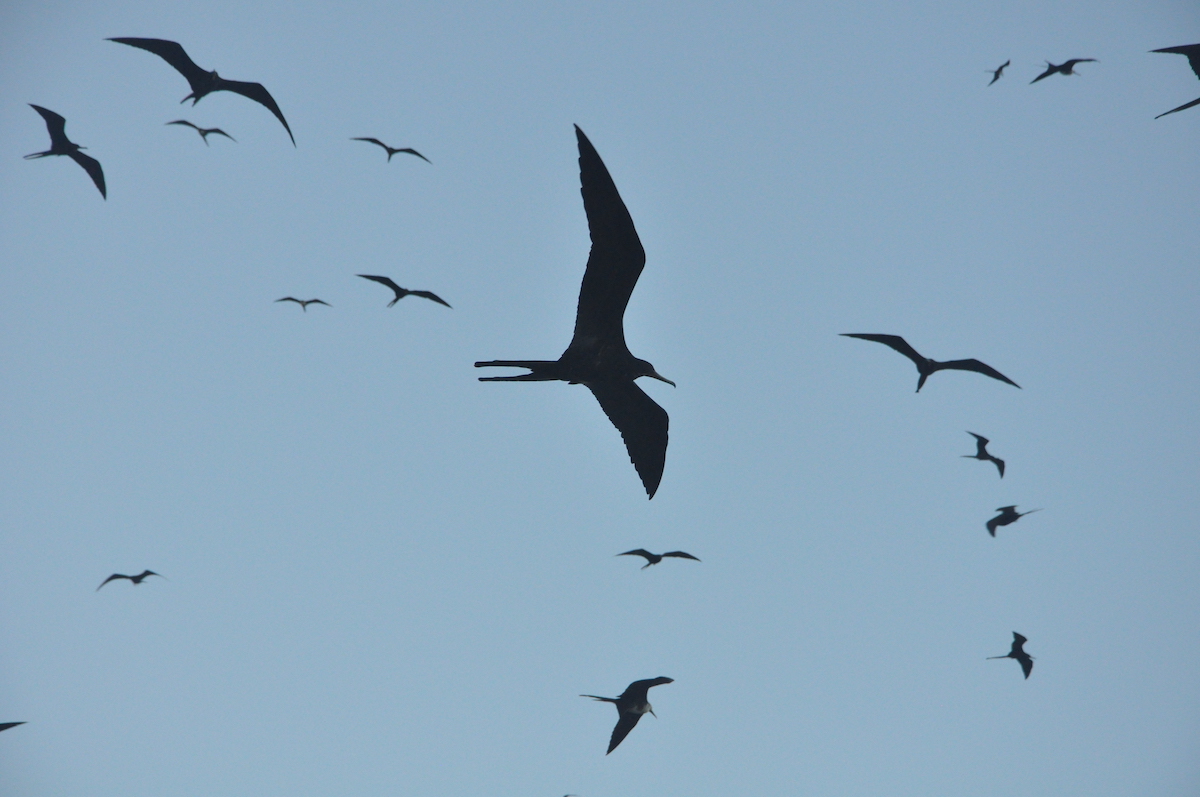
Magnificent frigate birds dot the sky above Great Tobago. (Photo: FREEMAN ROGERS)
In the daytime, hundreds of the birds circle above Great Tobago; at night, most settle in nests in the low trees along the rocky coastline. But where they go when they leave the colony is a largely a mystery. Scientists hope the ongoing tracking effort — which they believe may be the first of its kind involving Caribbean frigate birds — will help find answers.
The issue is not merely academic: The birds face serious threats. Some dangers are close to home — such as egg-eating goats, which the NPT is trying to eradicate from the island — but others come from farther afield. Researchers, for example, have found as many as 60 dead birds tangled in fishing line on Great Tobago in a single year. Tracking data can help decide where to focus education efforts.
“Part of what we’ve done is we’ve worked with [the Conservation and Fisheries Department] and developed signage,” Ms. Zaluski said, adding, “We want the public to know if they hook a bird they should reel it in and release it, versus just cutting the line.”
The data can also help gauge the health of marine ecosystems in the region.
“Fishermen have been using birds for hundreds of years as fish finders, and even now still they do it,” Mr. Zaluski explained. “And so this is kind of giving you a map of what’s going on in the ocean.”
Such information is in short supply when it comes to Caribbean seabirds, said Dr. Pat Jodice, a South Carolina-based biologist who has assisted in tagging initiatives here and elsewhere in the region.
“You can look at some really remote places on Earth like Antarctica and the islands around it, and there have been hundreds of papers published on seabirds from those places,” he said. “But when you look at the Caribbean, which is a couple hours away from the continental US, there is an incredible gap in our understanding.”
As part of efforts to fill that gap, Dr. Jodice helped conduct a 2012 workshop in the Bahamas for Caribbean conservationists. Organisers hoped to meet collaborators willing to assist with projects in the region, and Ms. Zaluski was among several attendees who fit the bill.
“I basically just kept in touch with Susan and talked to her about tracking opportunities … and thought that she would be a really strong partner for some tracking work,” Dr. Jodice said.
Ms. Zaluski was subsequently invited to a follow-up workshop in Pedro Cays, Jamaica, where she received training in bird tagging. Since then, three different types of tag have been used to track Great Tobago seabirds.
Tagging tech
Bird tagging is not new. The ancient Romans sent messages by tying string to crows’ legs. In the early 1800s, the American naturalist James Audubon used a similar technique as part of his pioneering studies: He wrapped silver thread around the legs of songbirds in order to track their annual migration.
Recent decades have changed the game. Perhaps most importantly, technological advances have allowed for the production of smaller transmitters — a crucial development given that scientists believe that a tag should weigh less than three percent of a bird’s body weight.
Asked to describe the progress during his two decades studying seabirds, Dr. Jodice was at a loss for words.
“It’s hard to explain, to be honest,” he said. “It would be like asking someone to explain how a cell phone has changed over 20 years: You go back to those giant cell phones we were all excited to have and carry around in our cars compared to what we have now.”
When Dr. Jodice started his career, birds were often tracked with radio tags, which had been around for decades.
“Radio tags put out a signal and you have to go find it; you have to be close enough to the radio signal to pick it up with a receiver, just like in your car with an FM radio,” he said. “So if it goes someplace you’re not expecting it to go, you may not find it.”
Today, technology has eliminated this necessity: Certain types of tag enable a bird’s movements to be monitored from anywhere in the world over the Internet.
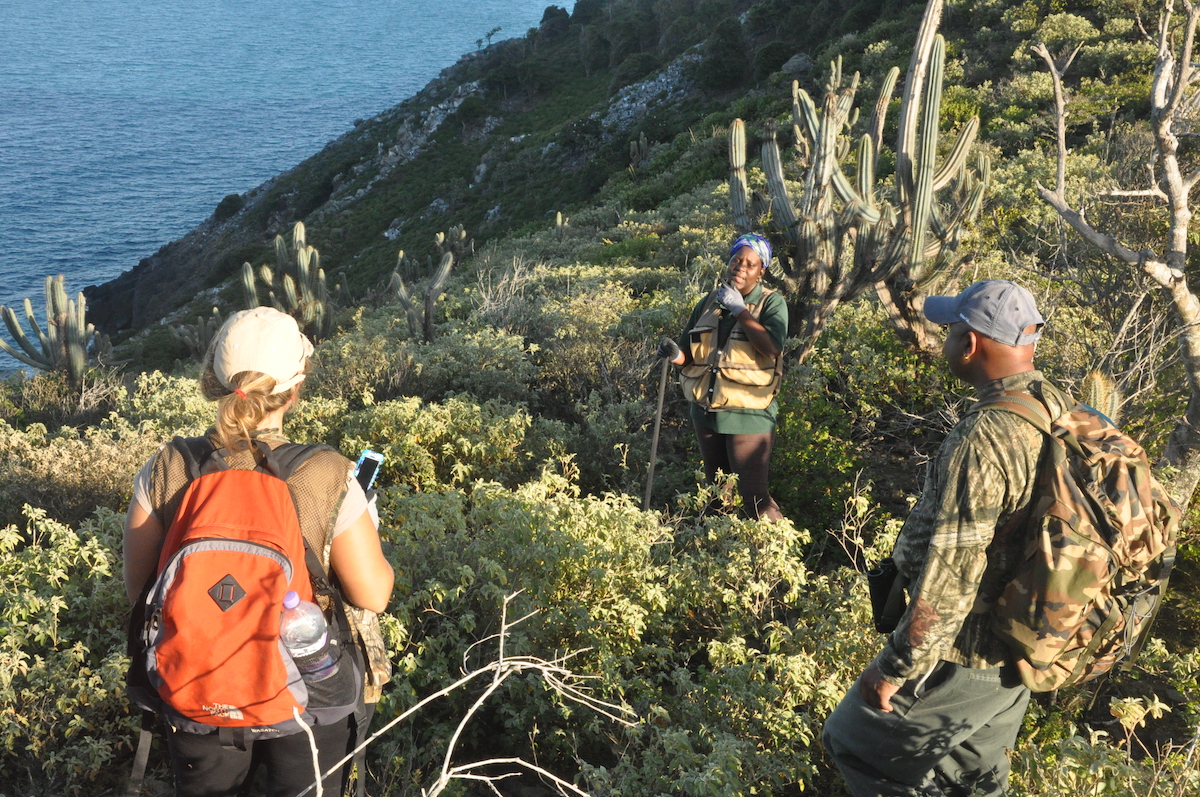
Three types of tags
The first tags deployed at Great Tobago were originally designed to track humans, not birds. Funded by a grant from the United Kingdom’s Darwin Initiative, researchers purchased several i-gotU-brand loggers, which are typically used by hikers to record their travels via the Global Positioning System.
Working with Dr. Louise Soanes, an Anguilla-based zoologist, Ms. Zaluski and other researchers waterproofed the tags by covering them in shrink-wrap. Then they attached the battery-powered devices to frigate birds and brown boobies starting in mid 2013.
The i-gotU loggers are relatively inexpensive — they cost about $60 each — but there is a drawback: Because they don’t transmit a signal, they have to be retrieved so that the data they collect can be downloaded. On Great Tobago, where the bird colonies are difficult to access, this process proved challenging.
“I think in total we deployed around 20,” Ms. Zaluski said, “and we’ve only gotten around four or five back.”
The second tagging effort was more successful. It came after Dr. Jodice obtained federal funding to purchase three satellite tags. The solar-powered devices are expensive — each one costs about $3,000, and there is a monthly charge of about $200 to receive their transmissions — but they don’t need to be retrieved. Instead, they broadcast a regular signal to a satellite, allowing the birds to be tracked in real time.
To deploy the tags on Great Tobago, Ms. Zaluski and other VI partners worked with Dr. Ken Meyer, the executive director of the Florida-based Avian Research and Conservation Institute.
Tiny backpacks containing the tags were affixed to three frigate birds, which were each given a name: Clive, after VI birder Clive Petrovic; Atoya, after the CFD staffer; and Boyd, after former Governor Boyd McCleary, whose office footed the monthly satellite charges through the Overseas Territories Programme Fund.
“As long as the tag can make contact with the satellite, you’ll get information on where that bird is within 500 metres or a couple kilometres,” Dr. Jodice said. “All I have to do is go to my computer.”
The tags transmit a signal for eight hours before shutting down for 52 hours to recharge. Though this process leaves substantial gaps in the data, the devices worked well for long-term tracking.
“The males actually went a lot further than we had realised,” Ms. Zaluski said. “One flew directly to Cuba and spent the summer in Cuba, and then another one of the males … flew to Jamaica and then down to Colombia, and then back up to the colony.”
Though Atoya’s tag stopped transmitting in August, Boyd and Clive are still active, and their movements can be tracked online.
A third type of tag, which was deployed during the team’s visit last month, uses a new type of technology. Designed especially for bird tracking, “GPS-GSM loggers” transmit to cell phone towers to track birds’ movements in real time. At about $600 each — plus about $20 per month to receive data — the tags are significantly cheaper than the satellite version, but they tend to fall off after a few weeks. Because they transmit every ten minutes, however, they are better suited for tracking smaller scale movements.
“I would say the GPS fixes are accurate to about ten feet,” Ms. Zaluski said.
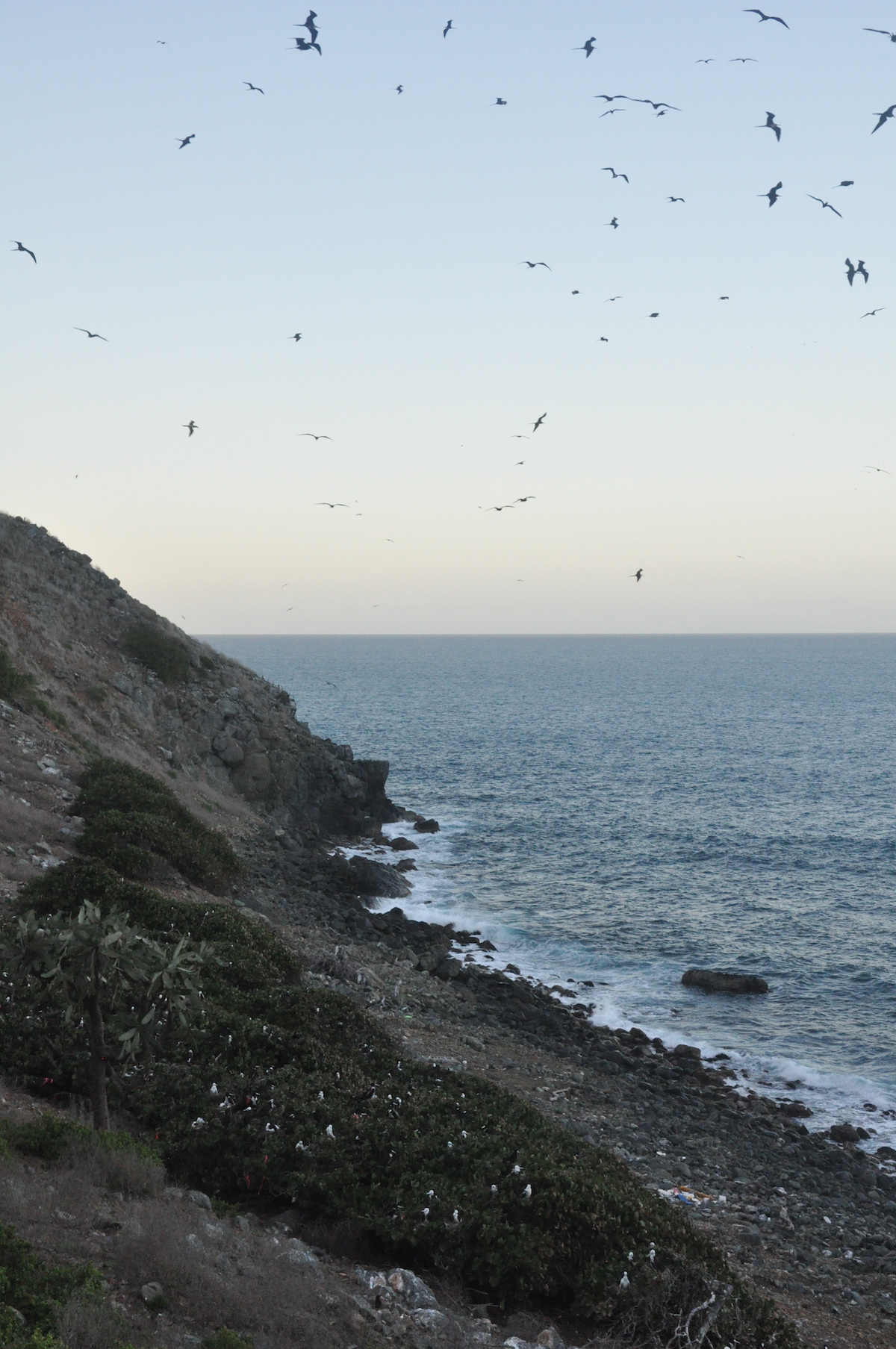
‘Exciting stuff’
Though it was after 1 a.m. when the team finished tagging the fourth bird on Feb. 20, they couldn’t rest yet. They still had to hike back to the other side of the island, where they had set up camp at the only bay on Great Tobago that is easily accessible by boat.
Using their headlamps to navigate the steep terrain, they did their best to avoid the painful jumping cactus that nevertheless collected on their pants and boots. After about an hour of hiking under the stars, they arrived at camp, ate, and crawled into sleeping bags.
In the morning, they returned home aboard the NPT boat Rhone Ranger. Shortly thereafter, Ms. Zaluski forwarded an e-mail from Dr. Soanes, who was monitoring the four tags from Anguilla as part of a two-year project for the University of Liverpool.
“One is in Puerto Rico already and one is in St. John,” Dr. Soanes wrote of the tagged birds. “The other two have checked in but are still at the colony. Exciting stuff!!!”
For the next couple days, the tags showed the birds’ travels around this territory, the United States VI, and Puerto Rico. Then, to the researchers’ disappointment, they stopped transmitting.
This week, however, brought good news: One of the birds — a female named Cuckoo — had “checked back in,” Ms. Zaluski said Tuesday. New data showed that the bird had flown hundreds of miles northeast over the open ocean before doubling back to Antigua.
“This is really exciting news,” Ms. Zaluski said.
Cuckoo, she explained, had probably flown out of range of cell phone towers, and her return suggests that the other three birds might resurface as well.
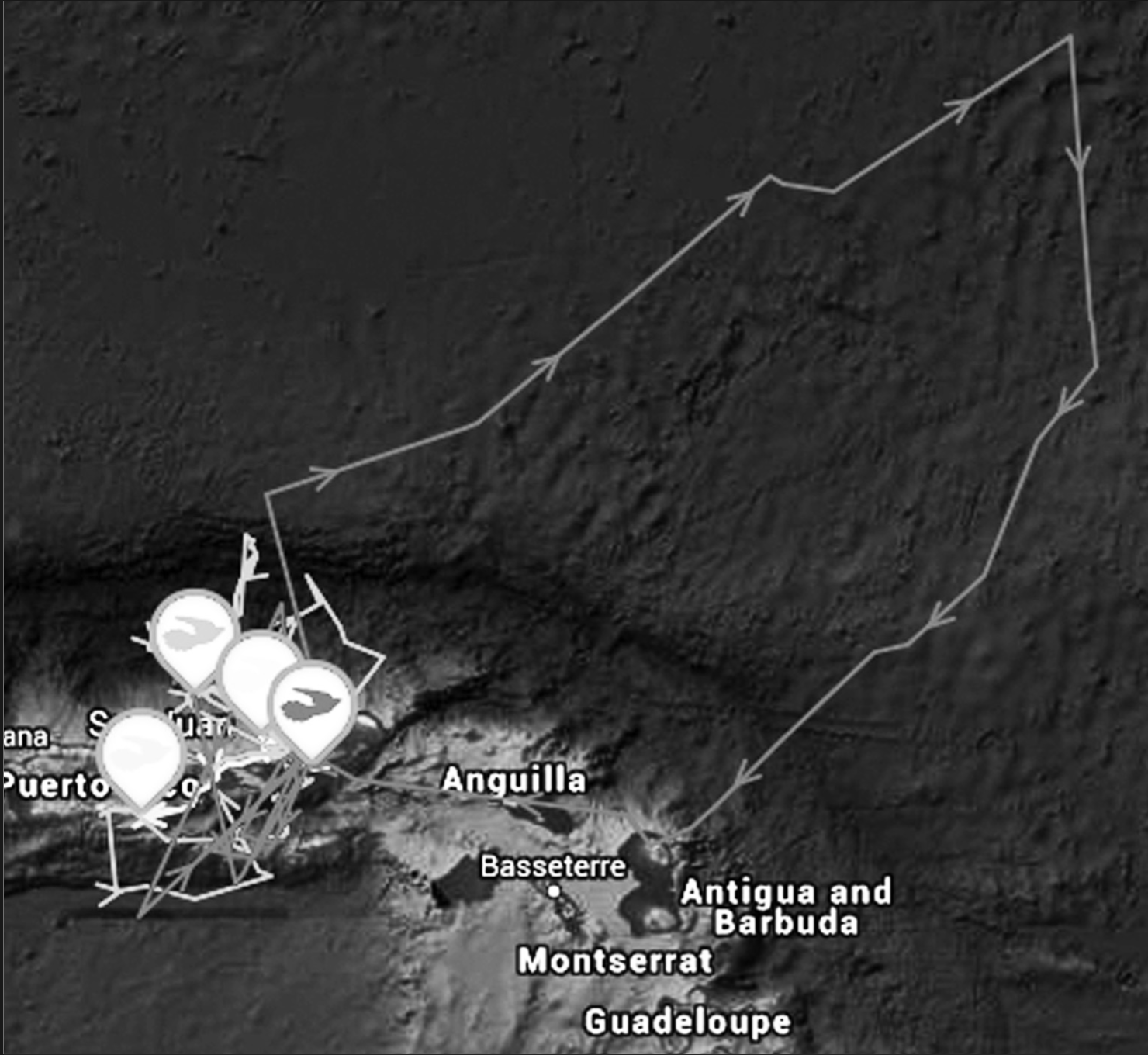
Though the tags haven’t transmitted as consistently as researchers had hoped, such setbacks are not particularly surprising.
“A lot of the species in the Caribbean have not been tracked before,” Dr. Jodice said. “So you have to figure out how to attach a device to them or how they handle that device. So the first step is sort of figuring that part out: Can we catch them? Can we get a device on them that fits well? Do they tolerate that device?”
He also cautioned against drawing broad conclusions from the limited data available so far.
“What you really want to do is use these small sample sizes that we have to generate public interest in the countries where the birds are nesting,” Dr. Jodice said, adding that he would like to track more VI birds in the future.
Still, the information already gleaned from the tags highlights an important point, he said.
“It’s nice for people who live in the BVI to think of these birds as BVI birds, but they’re not: They might nest there, but they spend time in Cuban waters, Puerto Rico waters, international waters,” he said, adding, “If they were carrying passports, they would have a lot of stamps in them. And our management plans, our conservation plans, our scientific hypotheses need to take all that into consideration.”
New project
The future of tagging is bright. As technology promises to make trackers smaller and more affordable, new options are fast becoming available.
Researchers in the VI plan to take full advantage. This month, Ms. Zaluski, Dr. Soanes and other partners are launching a new Darwin Initiative-funded project to study the 15 species of seabirds that breed in the territory.
As part of the effort, they hope track an endangered species that’s about a tenth the size of an average frigate bird: the roseate tern. They plan to use tags that weigh about three grams each.
“It’s really new technology: smaller and cheaper,” Dr. Soanes said. “It’ll open a lot of options.”